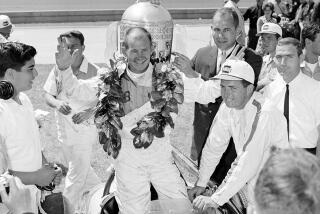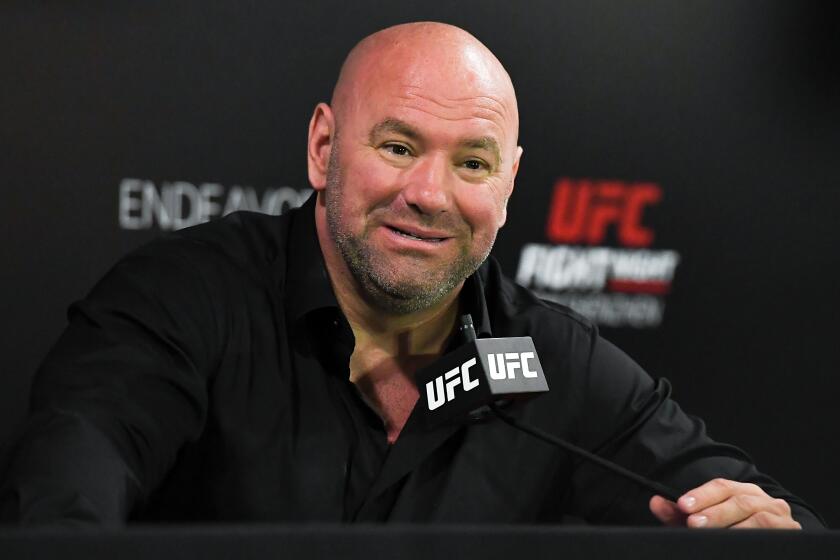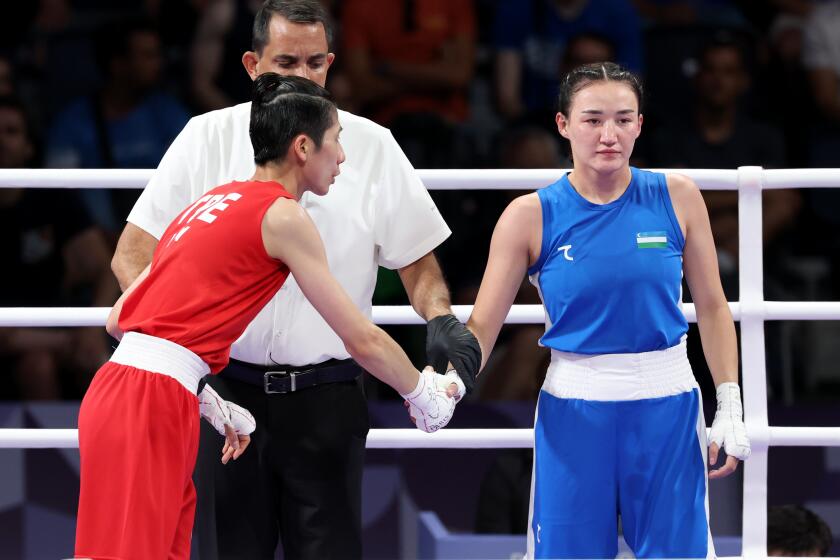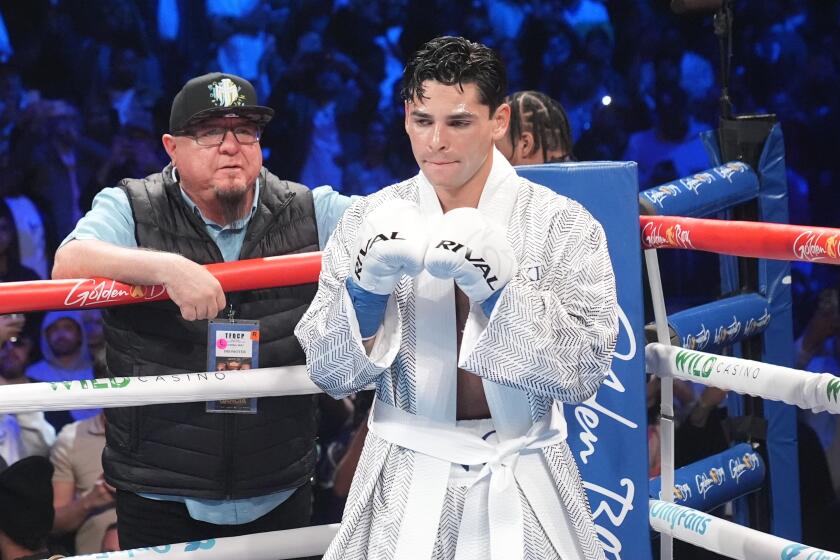Little Al Unser Spins Wheel of Misfortune
INDIANAPOLIS — Emerson Fittipaldi, who fights out of Brazil, won the heavyweight championship of racing Sunday with a 15th-round knockout.
Kayoed was Al Unser Jr. who was ahead on all cards at the time, when he ran into a picture-book right that sent young Unser crashing to the floor and a 10-count for the day.
The question is, “Was it a clean shot?” Look at it this way: If you knock a guy out with a foul, do you get the title? Remember Jack Sharkey knocked out Max Schmeling in a title fight in 1930 but the ruling was, the knockout was a low blow. Schmeling was named champion, though on the floor at the end.
The Emerson Fittipaldi-Al Unser Jr. slugfest at Indy Sunday was a throwback auto race. Only in old Hollywood movies do you see wheel-to-wheel racing of the kind popularized by Clark Gable movies where his rival for the affections of Loretta Young is usually depicted as crowding him homicidally into a wall on the track.
But Emmo and Little Al turned the clock back Sunday to the days when racing cars were not just complicated missiles controlled by an instrument panel as futuristic as a spaceship. They went at each other like Dempsey and Tunney or Ali and Frazier in the late stages of the 73rd Indy 500 when all the ribbon clerks had been run out of the pot.
It was on the 199th lap with one to go when Fittipaldi landed the Sunday punch. Marciano never landed a better one.
The circumstances were these: The two drivers were the only survivors, the only ones on lap 199, of a high speed race in which contenders were dropping out like swatted flies. First one, and then the other, were in the lead. It was like a He’s up! He’s down! fight.
On Turn 3, next-to-last lap, Fittipaldi decided desperate measures were called for. He was like a fighter who knew he needed a knockout to win. He dove for a hole between Al Unser’s car who was a car length ahead of him and the infield of the track. There was a third car, driven by an also-ran named Ludwig Heimrath Jr. to the outside of both of them.
The thing you have to remember is, Fittipaldi’s car was almost down in the infield grass when it tried to squeeze past.
Now, the rules of racing at Indy this year called for all cars to remain above a white line drawn around the track oval just in from the infield dirt.
Emerson Fittipaldi’s whole car was below that white line. Now, the question becomes--does the fact that Fittipaldi was there require that Unser make a racing decision to give him room? Should Unser have gone around, or squeezed over on Heimrath? Or did the fact Fittipaldi was taking a questionable shortcut disenfranchise him? If it was football, would they have dropped a flag? If it was horse racing, would they have taken down the number? If baseball, do they play the game under protest?
It’s academic. In Indy, as in an alley fight, it’s protect-yourself-at-all-times. They don’t take your number down at Indy. Hit-and-run accidents take place all the time.
What happened was, as the two cars came into the space with room for only one, Fittipaldi’s right front wheel slammed into Unser’s left rear.
It could have been a double-knockout and awarded the race to a guy who was five laps behind at the time, albeit in third place.
Instead, it was Little Al who took the count. Fittipaldi by a knockout. He flattened him. The good news is, he didn’t kill him.
It was the kind of racing you all too seldom see anymore. Cars fight at long range like battleships, or missile frigates, in these times.
But, when you get knocked out of the biggest prize in racing when you’re leading with only a little more than a lap to go, what do you do? Go home and kick the dog? Yell at the kids? Punch walls?
A.J. Foyt would have punched the driver who did it to him. Pit brawls have broken out over less at stock-car racing.
Young Al Unser, as soon as he was able to crawl out of the charred, mangled hunk of metal that had been his race car, stood trackside and applauded his tormentor and raised thumbs-up in tribute to him.
“I was just congratulating Emmo on a terrific piece of driving,” he was to say with apparent sincerity. “I was cheering for him because he’s one of the world’s great drivers. I was very impressed with his driving.”
Try that the next time somebody bumps you into the guard-rail on the Santa Monica Freeway.
Young Master Unser showed up at his post-race news conference with the big smile of a kid who has just been to his first circus. Little Al could play Baby Face Nelson without makeup. You see him and you want to take him to Disneyland.
But, he was so understanding about the accident, he’d ruin the movie script. He almost acted as if he had it coming to him. Did he think it was his fault, an incredulous sportswriter asked him.
“Was it my fault? No,” shot back Unser. “I had my front end in front of him but neither one of us was going to ‘lift’ (take his foot off the accelerator in close quarters) in that situation. I know I wasn’t going to lift. And I sure knew Emerson wasn’t going to lift, either.”
Did he know what the risks were? Unser smiles wryly. “I knew only one car was going to come out of that,” he admits.
Did a veteran driver outslicker the kid? Fittipaldi is a quondam world champion Formula One driver who left the chic circuits of the French Riviera to take up the neighborhood garage, brutish oval racing of Indy. There are few tricks of any kind of racing unknown to Emmo.
Would he have been able to do that to an older Unser? To a Foyt, Johnny Rutherford--even a Ray Harroun?
Fittipaldi is recognized as rough competition by the Indy trade. He’s no silk scarf, monocle driver, even though he knows too well what salad fork to use. You go into the corners with Fittipaldi about as optimistically as you would go in Gestapo headquarters.
He had to stave off several generations of the Unser family, Andretti family, to say nothing of the Bettenhausens and other familiar syllables of Indy track to win Sunday.
He did it with a right that would rank in history with the one Marciano used to deck Walcott with. Kid Unser never saw it coming. That’s why the title is going to Brazil this weekend and the Unsers have still another car in a bag to go with the dozens of others they’ve hung on a wall in their colorful Speedway history. The Unsers make more history here than a roomful of Hoosier politicians--including Dan Quayle.
More to Read
Go beyond the scoreboard
Get the latest on L.A.'s teams in the daily Sports Report newsletter.
You may occasionally receive promotional content from the Los Angeles Times.










